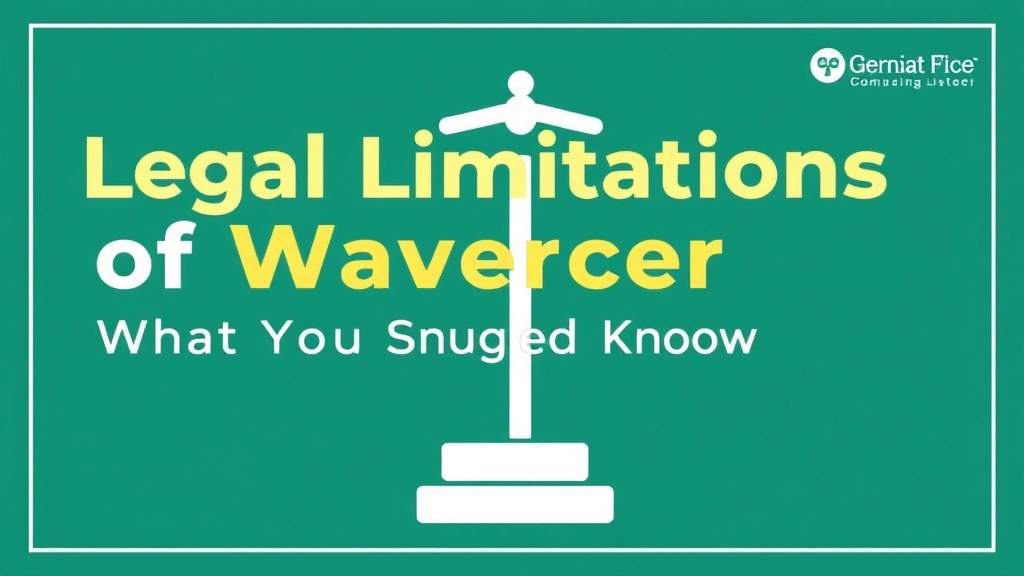Welcome to the Ultimate Guide on Summer Camp Waivers!
If you’re a camp organizer or a parent, understanding the intricacies of a summer camp waiver is crucial for ensuring a safe and enjoyable experience for all. A summer camp waiver is more than just a piece of paper; it’s a legal document that outlines the risks associated with camp activities and releases the camp from certain liabilities. In this article, we’ll dive deep into what a summer camp waiver entails, the key elements it should include, and the common mistakes to avoid when drafting one.
We’ll also explore the benefits of digital waivers, how to create them, and why they are becoming the go-to solution for many camps. From understanding liability protection and legal limitations to customizing your waiver for specific activities, this guide covers it all. Plus, we’ll offer practical tips for parents to consider before signing a waiver and steps to ensure compliance and safety. So, whether you’re looking to protect your camp legally or ensure your child’s safety, read on to get all the insights you need!
What is a Summer Camp Waiver?
Alright, let’s kick things off. You’re probably wondering, “What exactly is a summer camp waiver, and why do I need one?” Great question. A summer camp waiver is a legal document that parents or guardians sign to acknowledge the risks involved in camp activities and to release the camp from certain liabilities. It’s like a safety net for camp organisers, ensuring that everyone’s on the same page about the potential risks and responsibilities.
Why Do Camps Require Waivers?
If you’ve ever sent your kid off to camp, you know the mix of excitement and worry. Will they be safe? What if they get hurt? Camps require waivers to address these concerns and to protect themselves legally. Here’s why:
- Liability Protection: Camps are filled with activities like swimming, hiking, and rock climbing. While these activities are fun, they come with risks. A waiver helps protect the camp from legal claims if something goes wrong.
- Clear Communication: It ensures that parents are fully aware of the risks involved. Transparency is key here.
- Risk Management: By signing a waiver, parents acknowledge that they understand the risks and are willing to accept them.
What Does a Summer Camp Waiver Cover?
A solid summer camp waiver isn’t just a piece of paper. It’s a comprehensive document that covers:
- Inherent Risks: These are the everyday risks associated with camp activities, like tripping on a hike or getting a sunburn.
- Medical Emergencies: What happens if your child needs medical attention? The waiver often includes consent for emergency medical treatment.
- Behavioural Expectations: Some waivers outline the camp’s code of conduct and what happens if a camper breaks the rules.
- Release of Liability: This is the big one. Parents agree not to hold the camp responsible for certain types of injuries or accidents.
Real-Life Example
Let’s say your kid is super excited about the zip line. You sign the waiver, acknowledging that zip lining is risky. If your child gets a minor injury, the waiver typically means you can’t sue the camp for that specific incident. It’s all about setting expectations and understanding the risks.
For more information on how to prepare your child for camp and ensure their safety, check out our top tips for summer tent camping and learn about summer camp insurance coverage, benefits, and costs.
Key Elements of a Summer Camp Waiver Form

Alright, let’s get straight to it.
What should be in a summer camp waiver form?
You’re probably asking yourself, “What exactly needs to be in this thing to make sure we’re covered?”
First off, let’s talk about why you need a waiver.
It’s all about protecting your camp from liability while keeping parents informed.
Now, let’s break it down.
1. Clear Identification
Who’s this waiver for?
You need the camper’s full name and the parent or guardian’s name.
2. Informed Consent
Parents need to know what they’re signing up for.
List out the activities and any potential risks.
3. Assumption of Risk
This is where you say, “Hey, we’ve told you the risks, and you’re cool with it.”
Parents acknowledge they understand and accept these risks.
4. Medical Information
You need to know about any medical conditions, allergies, and emergency contacts.
This isn’t just about covering your back; it’s about keeping kids safe.
5. Release of Liability
Here’s the meat and potatoes.
Parents agree not to hold the camp responsible for injuries or accidents.
6. Photo and Video Release
Will you be snapping pics or taking videos?
Get permission to use those images for promotional purposes.
7. Legal Language
Yeah, it sounds boring, but it’s crucial.
Include statements that make the waiver legally binding.
8. Signature and Date
This seals the deal.
Both parent and camper (if old enough) should sign and date the form.
Real Talk
Ever had a parent come back and say, “I didn’t know this could happen”?
That’s why you need all these elements.
It’s not just a piece of paper; it’s a conversation starter.
Pro Tip
Want to make sure you’ve covered all bases?
Run your waiver by a legal professional.
It’s worth the investment.
How to Create a Digital Summer Camp Waiver
Got a summer camp and worried about liability issues? Let’s face it, the last thing you want is to be bogged down by legal problems when you should be focusing on giving kids the best summer ever. So, how do you cover your bases? A digital summer camp waiver is your answer.
Why Go Digital?
First off, why even bother with a digital waiver? Paper forms are so last decade. Here’s why digital is the way to go:
- Convenience: Parents can fill it out anytime, anywhere.
- Efficiency: No more sorting through stacks of paper.
- Accessibility: Easy to store and retrieve.
- Eco-Friendly: Save trees, folks!
Steps to Create a Digital Summer Camp Waiver
Alright, let’s get into the nitty-gritty. How do you actually create one of these bad boys? Here’s a step-by-step guide:
- Choose a Platform:
- There are tons of online platforms like JotForm, WaiverForever, or even Google Forms. Pick one that suits your needs.
- Draft the Content:
- Introduction: Explain what the waiver is for.
- Participant Information: Name, age, emergency contact details.
- Acknowledgment of Risks: Clearly outline the risks involved in camp activities.
- Medical Information: Any allergies or medical conditions.
- Consent: A section where parents agree to the terms and conditions.
- Signature: Digital signature field for parents to sign.
- Design the Form:
- Keep it simple and straightforward.
- Use clear, readable fonts.
- Include your camp logo for branding.
- Test It Out:
- Before going live, test the form yourself.
- Ensure it’s mobile-friendly.
- Check that all fields are working correctly.
- Distribute the Waiver:
- Send it out via email.
- Post it on your camp’s website.
- Share it on social media platforms.
Real-World Example
Imagine this: Sarah, a busy mum of two, wants to register her kids for summer camp. She gets an email with a link to the digital waiver. She clicks on it, fills it out in five minutes while sipping her morning coffee, and hits submit. Done and dusted. No fuss, no muss.
Key Elements to Include
Don’t miss these crucial elements when drafting your waiver:
- Clear Language: Avoid legal jargon. Make it easy to understand.
- Comprehensive Risk List: Cover all potential risks, from minor injuries to severe accidents.
- Emergency Procedures: Outline what steps will be taken in case of an emergency.
- Parental Consent: Ensure there’s a clear section for parental consent.
Avoiding Common Pitfalls
Here are some common mistakes to steer clear of:
- Vague Language: Be specific about the risks.
- Missing Signatures: Ensure there’s a digital signature field.
- Not Testing: Always test the form before distributing it.
For more tips on creating a safe and fun summer camp experience, check out our Summer Camp Cabin Safety and Design Tips and discover the 2024 Summer Camp Guide.
Understanding Liability Protection for Camps

Ever wondered what happens if a kid gets hurt at summer camp?
That’s where liability protection comes in.
Let’s break it down.
What is Liability Protection?
Liability protection is like a safety net for camps.
It helps cover the camp if something goes wrong.
Think of it as insurance for accidents and mishaps.
Why Do Camps Need It?
Kids are adventurous.
They climb trees, swim in lakes, and play sports.
Accidents happen.
Without liability protection, camps could face serious legal trouble.
This protection ensures camps can handle claims without going bankrupt.
How Does It Work?
When you sign a waiver, you’re acknowledging the risks.
You’re saying, “I get it, stuff happens.”
This doesn’t mean camps can be careless.
They still need to follow safety rules.
Key Points to Remember:
- Waivers aren’t bulletproof. They help, but don’t cover everything.
- Safety first. Camps must maintain a safe environment.
- Clear communication. Parents should know what they’re signing.
Real Talk:
Imagine you’re chatting with a friend over coffee.
Your kid’s going to camp, and you’re worried about safety.
You ask, “What if my child gets hurt?”
Your friend says, “The camp has liability protection. It’s like a safety net.”
You feel a bit better, right?
That’s the goal here.
Breaking It Down:
- Understand the risks. Know what activities are included.
- Read the waiver carefully. Don’t just sign blindly.
- Ask questions. If something’s unclear, get answers.
Liability protection is crucial for camps.
It’s there to protect both the camp and your child.
So next time you see a waiver, remember, it’s part of keeping everyone safe.
Stay informed, stay safe, and enjoy the summer!
Common Mistakes When Drafting a Camp Waiver
Alright, let’s get real for a second. Drafting a summer camp waiver can feel like trying to solve a Rubik’s Cube blindfolded. But trust me, it’s not as hard as it seems. If you’re running a summer camp, you’ve probably got a million things on your plate. The last thing you need is a sloppy waiver that doesn’t protect you or your campers. So, let’s dive into some common mistakes that you can avoid to make your life a lot easier.
Being Too Vague
One of the biggest mistakes? Being too vague. If your waiver reads like a mystery novel, you’re doing it wrong. Be specific about the activities, risks, and responsibilities. For example:
- Wrong: “Participants may face some risks.”
- Right: “Participants may face risks such as sprained ankles, insect bites, and sunburns during activities like hiking, swimming, and archery.”
Legal Jargon Overload
Look, no one wants to read a waiver that feels like it was written by a robot lawyer. Keep it simple. Use plain language that everyone can understand. Here’s a quick tip: If a 12-year-old can’t understand it, it’s too complicated.
Ignoring Local Laws
Not all waivers are created equal. What works in one place might be useless in another. Make sure you’re aware of local laws and regulations. Consult a legal expert who knows the ins and outs of your area.
Missing Essential Elements
Your waiver should include:
- Clear identification of the parties involved (camp, participant, and guardian).
- Detailed description of activities and associated risks.
- Acknowledgement of understanding and assumption of risks.
- Consent to medical treatment if necessary.
- Release of liability for the camp and its staff.
Not Updating Regularly
Things change. New activities, new risks, new laws. Make it a habit to review and update your waiver at least once a year.
Skipping the Digital Option
In today’s world, a digital waiver isn’t just a nice-to-have; it’s a must-have. It’s more convenient, easier to store, and quicker to access. Plus, it makes your camp look modern and professional.
Forgetting to Test
Once you’ve drafted your waiver, test it. Show it to a few parents and see if they understand it. If they have questions or seem confused, go back and tweak it.
Ignoring Feedback
Parents will have questions and concerns. Listen to them. Their feedback can help you improve your waiver and make it more effective.
Real-Life Example
Imagine you’re running a summer camp, and one of the activities is rock climbing. You draft a waiver that says, âParticipants may face some risks.â A parent signs it, thinking the risks are minor. Then, their child gets a minor injury. The parent claims they weren’t aware of the specific risks. Now you’re in hot water. If your waiver had clearly stated, âParticipants may face risks such as falling, scraping knees, and bruising during rock climbing,â you’d be in a much better position.
Drafting a summer camp waiver doesn’t have to be a headache. Avoid these common mistakes, and you’ll be well on your way to creating a solid, effective waiver. Remember, the goal is to protect both you and your campers. Keep it clear, keep it simple, and keep it updated.
Got any questions or want to share your own experiences? Drop a comment below! We’re all in this together, and sharing insights can make us all better.
Stay tuned for more tips on creating the perfect summer camp experience. Cheers! If you’re looking for more specific advice, check out our guide on custom summer camp name tags and our ultimate summer camp schedule template guide.
Legal Limitations of Waivers: What You Should Know

Ever wondered if a summer camp waiver really has your back? Let’s break it down.
What’s the Deal with Waivers?
First off, a waiver isn’t a magic shield. It’s a legal document, sure, but it’s got its limits.
Key Limitations You Need to Know
1. Gross Negligence and Intentional Harm Aren’t Covered
- If the camp is blatantly careless or intentionally harmful, the waiver won’t save them.
- Basically, if they mess up big time, they’re still on the hook.
2. Minors and Waivers
- Parents sign waivers for their kids, right?
- But in many places, courts don’t always enforce waivers signed on behalf of minors.
- So, a child might still sue for injuries despite the waiver.
3. Local Laws Vary
- Waivers are subject to the laws of the land.
- What flies in one place might get shot down in another.
- Always check local regulations to see how far your waiver can go.
Real Talk: What This Means for You
Imagine this: Your kid’s at camp, and the staff ignores obvious safety hazards. The waiver you signed? It won’t cover that.
Or, the camp is in a state where waivers for minors are basically useless. So, even if you signed, you might still have legal options if something goes wrong.
Why This Matters
Understanding these limitations helps you make better decisions. You won’t be lulled into a false sense of security.
Key Takeaways
- Gross Negligence and Intentional Harm: Waivers don’t cover these.
- Minors: Waivers for kids might not hold up in court.
- Local Laws: These can make or break your waiver’s effectiveness.
Stay Informed
Always read the fine print. Ask questions. Know what you’re signing up for. That’s how you keep your kids safe and your mind at ease.
Why Digital Waivers Are Better for Summer Camps
Ever found yourself drowning in a sea of paperwork just to get your kid into summer camp? Believe me, I’ve been there. It’s a nightmare. But here’s the kicker: digital waivers are changing the game, and for good reason.
What’s the Deal with Digital Waivers?
First off, let’s address the big question: why go digital? Well, here’s the lowdown:
- Convenience: No more printing, signing, and scanning. You can handle everything from your phone or laptop.
- Efficiency: Digital waivers streamline the process. Camp organisers can quickly sort and store waivers without the mess of physical papers.
- Accessibility: Need to check something? Digital waivers are always a click away, saving you from rummaging through piles of paper.
Real Concerns from Real Parents
Parents often worry about the safety and legality of digital waivers. Are they as secure as paper forms? Will they hold up in court? The answer is a resounding yes. Digital waivers are encrypted and legally binding, offering the same protection as their paper counterparts.
Benefits for Camp Organisers
Now, let’s get into the nitty-gritty of why camp organisers should make the switch:
- Time-Saving: Imagine not having to chase down parents for signed forms. Digital waivers can be sent and signed in minutes.
- Error Reduction: Digital forms can be set up to ensure all necessary fields are filled out, reducing the risk of incomplete waivers.
- Eco-Friendly: Going paperless isn’t just trendy; it’s a responsible choice for the environment.
Real-Life Example
Think about a camp like âAdventure Quest.â They switched to digital waivers last summer and saw a 40% increase in on-time submissions. Parents loved the ease, and the staff had more time to focus on what really matters: creating an unforgettable camp experience.
How to Implement Digital Waivers
Ready to make the switch? Here are some steps to get you started:
- Choose a Platform: Find a reliable digital waiver platform. Look for features like e-signatures, encryption, and easy integration.
- Customise Your Waiver: Make sure your digital waiver covers all necessary legal bases and is tailored to your camp’s activities.
- Test the System: Before going live, test the process with a few parents to iron out any kinks.
- Communicate with Parents: Let parents know why you’re making the switch and how it benefits them.
For more tips on running a successful camp, check out our guide on top qualities for effective summer camp leaders and explore some fun activities at summer camp to keep your campers engaged.
Customising Your Camp Waiver: Best Practices

Alright, let’s get straight to it.
How do you make sure your summer camp waiver is spot on?
You want it to cover all bases, right?
But you also don’t want it to be a headache for parents to read.
Here’s how you can nail it.
Why Customisation Matters
Every camp is different.
Different activities, different risks.
Your waiver should reflect that.
A cookie-cutter waiver won’t cut it.
Key Elements to Include
- Specific Activities: List out the activities. Be clear. Parents need to know what their kids are signing up for.
- Potential Risks: Be upfront about the risks. No sugar-coating. Transparency builds trust.
- Emergency Protocols: Outline what happens if something goes wrong. Who do you contact? What’s the procedure?
Make It User-Friendly
- Simple Language: No legal jargon. Use plain English. If you wouldn’t say it in a conversation, don’t write it.
- Bullet Points: Break down complex points. Easy to read, easy to understand.
- Bold Highlights: Important stuff? Make it stand out. Parents shouldn’t miss it.
Real-Life Example
Imagine you run a camp with a rock climbing activity.
Your waiver should say:
- Activity: Rock climbing.
- Risks: Falls, injuries from equipment, weather-related issues.
- Emergency Protocol: First aid on site, nearest hospital details, emergency contact numbers.
Get Feedback
Before finalising, get some parents to read it.
Ask them:
- Is it clear?
- Do they understand the risks?
- Any confusing parts?
Update Regularly
Things change.
New activities, new risks.
Review and update your waiver regularly.
Digital Customisation
Going digital?
- Interactive Forms: Use checkboxes and dropdowns. Make it easy to fill out.
- E-Signatures: Save time. Make it official with a digital signature.
Parental Considerations Before Signing a Waiver
Alright, let’s cut to the chase. You’re a parent, and you’re about to sign a summer camp waiver. You’ve got a million questions and a few worries, right? Let’s break it down so you can make an informed decision without the legal mumbo-jumbo.
What Exactly Are You Signing?
First off, what is a summer camp waiver? It’s a legal document that says you understand the risks involved in the camp activities and agree not to hold the camp liable if something goes wrong. Simple, right? But there’s more to it.
Key Questions to Ask
Before you put pen to paper, here are some burning questions you should be asking:
- What activities are included? Check if the waiver lists all the activities your child will participate in. Are there any high-risk ones like rock climbing or swimming?
- What’s the camp’s safety record? Do a bit of homework. Look up reviews or ask other parents about their experiences.
- Who’s supervising the kids? Are the staff trained professionals or just volunteers? This can make a huge difference in how safe your child will be.
What Should You Be Looking For?
When you get that waiver form, keep an eye out for these key elements:
- Clear language: The waiver should be easy to read. If it’s filled with legal jargon, ask for a simpler version.
- Specific risks: The document should list specific risks associated with camp activities. Vague terms like “general injuries” are a red flag.
- Emergency procedures: What’s the plan if something does go wrong? Make sure the waiver outlines the camp’s emergency protocols.
Real Concerns, Real Answers
Let’s say you’re worried about your child getting injured. Totally valid. Here’s what you can do:
- Ask for a tour: Visit the camp and check out the facilities. Are they well-maintained? Is the equipment up to date?
- Meet the staff: Talk to the camp counsellors and directors. Get a feel for their experience and how they handle emergencies.
- Check insurance: Does the camp have liability insurance? If yes, what does it cover?
The Fine Print: Legal Limitations
Remember, a waiver isn’t a get-out-of-jail-free card for the camp. If there’s negligence involved, the waiver might not hold up in court. So, don’t let the document scare you into thinking you have no rights.
Digital Waivers: A Modern Twist
In today’s digital age, many camps are moving towards digital waivers. They’re easier to store and retrieve, and you can sign them from the comfort of your home. Plus, they often come with added layers of security like electronic signatures.
Final Thoughts
So, before you sign that summer camp waiver, take a moment to review everything. Ask questions, do your research, and make sure you’re comfortable with what you’re agreeing to. After all, it’s your child’s safety on the line.
For more insights on how to prepare, check out our 1-week summer camp packing list essentials and learn about the optimal summer camp timetable guide to ensure your child has a safe and enjoyable experience.
Steps to Ensure Waiver Compliance and Safety
Hey, ever worried if your summer camp waiver is actually protecting you?
You’re not alone.
Let’s dive into how you can ensure waiver compliance and safety, so you can sleep easy knowing you’ve covered all bases.
Why Compliance Matters
First off, why should you care about waiver compliance?
Because it’s not just a piece of paper.
It’s your first line of defence against legal headaches.
And trust me, no one wants those.
Key Steps to Ensure Compliance
Here’s a no-nonsense guide to keep your waivers tight and your camps safe:
- Consult a Lawyer
- Sounds obvious, but so many skip this step.
- A legal expert can tailor your waiver to meet your specific needs.
- Use Clear Language
- Avoid legal jargon.
- Keep it simple so everyone understands what they’re signing.
- Include All Activities
- List every single activity your camp offers.
- Don’t leave anything out. If it’s not mentioned, it’s not covered.
- Highlight Risks
- Be upfront about potential risks.
- Transparency builds trust and protects you legally.
- Get Digital Signatures
- Digital waivers are easier to track and store.
- They also offer a timestamp, which is crucial for legal reasons.
Checking for Compliance
Once you’ve got your waiver drafted, how do you ensure it’s compliant?
- Regular Reviews
- Laws change. Your waiver should too.
- Schedule annual reviews with your lawyer.
- Staff Training
- Make sure your team understands the waiver.
- They should be able to explain it to parents and campers.
- Feedback Loop
- Get feedback from parents.
- If they’re confused, you need to simplify your waiver.
Real-Life Example
Imagine this: A kid breaks an arm during a climbing activity.
If your waiver clearly listed climbing as an activity and mentioned potential risks, you’re in a much better position.
If not, you could be facing a lawsuit.
Wrapping Up
Ensuring waiver compliance and safety isn’t just about avoiding lawsuits.
It’s about creating a transparent, trust-filled environment for everyone.
So, take these steps seriously.
Your peace of mindâand your camp’s reputationâdepend on it.
Got any questions or worried about something specific?
Drop a comment below, and let’s chat.
Remember, a solid waiver is your best friend in the camp world. For more tips on keeping your camp safe and fun, check out our Summer Camp Rules and Regulations Guide and our Secure Summer Camp Financial Aid Guide.
FAQs on Summer Camp Waiver
What is a Summer Camp Waiver?
A summer camp waiver is a legal document that parents sign to acknowledge the risks involved in camp activities and to release the camp from liability for injuries or accidents.
Why is a Summer Camp Waiver Necessary?
The waiver is crucial for protecting the camp from legal issues and for keeping parents informed about potential risks. It serves as a form of liability protection.
What Should Be Included in a Summer Camp Waiver?
A comprehensive waiver should include:
- Clear Identification: Camper’s and guardian’s full names.
- Informed Consent: Details of activities and their risks.
- Assumption of Risk: Acknowledgment of understanding and acceptance of risks.
- Medical Information: Medical conditions, allergies, and emergency contacts.
- Release of Liability: Agreement not to hold the camp responsible for injuries.
- Photo and Video Release: Permission to use images for promotional purposes.
- Legal Language: Statements to make the waiver legally binding.
- Signature and Date: Signatures from parents and campers (if applicable).
Does a Waiver Cover Everything?
No, waivers have limitations. They generally don’t cover gross negligence or intentional harm. Also, waivers for minors might not always hold up in court, depending on local laws.
How Can I Ensure My Waiver is Effective?
Customise the waiver to reflect specific camp activities and risks. Use simple language, bullet points, and bold highlights for important information. Regularly review and update the waiver to keep it current.
Should I Consult a Legal Professional?
Yes, it’s advisable to have a legal professional review your waiver to ensure it covers all necessary aspects and complies with local laws.
What If a Parent Claims They Weren’t Informed?
A well-crafted waiver serves as a conversation starter, ensuring parents are fully informed about the risks. Clear communication is key to avoiding misunderstandings.
How Does Liability Protection Work?
Liability protection acts as a safety net for camps. When parents sign a waiver, they acknowledge the risks involved. However, camps must still follow safety rules and maintain a safe environment.
Can Waivers Be Signed Digitally?
Yes, digital customisation is possible. Use interactive forms with checkboxes and dropdowns, and allow for e-signatures to make the process more efficient.
What Should I Do If My Waiver Needs Updating?
Regularly review and update your waiver to reflect new activities and risks. Get feedback from parents to ensure clarity and comprehensiveness.
References
-
Informed Consent and Waivers
-
Summer Camp Safety
-
Understanding Liability Waivers for Camps

